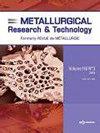高炉炼铁用高强度生物炭复合型煤的制备
IF 1.1
4区 材料科学
Q3 METALLURGY & METALLURGICAL ENGINEERING
引用次数: 4
摘要
以氧化铁颗粒(平均粒径为2.5 μm)和生物炭颗粒(平均粒径为50.0 μm)为原料,采用冷成型后热处理的方法制备了高炉用生物炭复合型煤(BCB)。针对其冷压强度,对制备工艺进行了优化。在模拟高炉条件下,对优化设计的BCB的抗粉碎性能、反应发展和结构演变进行了研究。结果表明,制备BCB的最佳温度为1073 K。优化设计的BCB含有11.10 wt。%碳,72.21吨。% fe3o4,重量为11.25;% FeO, 0.77 wt。% Fe, 6.44 wt。%的煤矸石,冷破碎强度为1800 N/型煤。模拟高炉条件下BCB的性能结果表明,BCB部分反应后的冷破碎强度范围为1500 ~ 5500 N/型煤,最大体积收缩度为0.45。渣基或铁网支撑了BCB的高抗粉性能。在模拟高炉工况下,BCB经历了气氛还原、部分自还原与气氛还原、完全自还原、部分自还原与气氛气化、气氛气化5个阶段。实验结果表明,在高炉内充装BCB,可以提高炉顶气体利用效率,对降低热储备区温度水平有良好的影响。本文章由计算机程序翻译,如有差异,请以英文原文为准。
Preparation of high-strength biochar composite briquette for blast furnace ironmaking
In this research, using iron-oxide fines (average size: 2.5 μm) and biochar fines (average size: 50.0 μm), the biochar composite briquette (BCB) for blast furnace (BF) application was prepared by cold briquetting followed by heat treatment. The preparing conditions were optimized regarding its cold crushing strength. Anti-pulverization capability, reaction development, and structure evolution of the optimally-designed BCB under simulated BF conditions were then examined. Results of optimizing BCB preparation conditions showed that a heating temperature of 1073 K was optimal for preparing the BCB. The optimally-designed BCB contained 11.10 wt.% carbon, 72.21 wt.% Fe3 O4 , 11.25 wt.% FeO, and 0.77 wt.% Fe, 6.44 wt.% gangue, and had a cold crushing strength of 1800 N/briquette. Results of BCB behavior under simulated BF conditions showed that the cold crushing strength after partial reaction of the BCB ranged from 1500 N/briquette to 5500 N/briquette and its maximum volume shrinkage degree was 0.45. The high anti-pulverization capability of the BCB was supported by the slag matrix or the iron network. Under the simulated BF conditions, the BCB underwent five stages of reduction by atmosphere, partial self-reduction and reduction by atmosphere, full self-reduction, partial self-reduction and gasification by atmosphere, and gasification by atmosphere. It is inferred from the experimental findings that, by charging the BCB in BF, an increase of top gas utilization efficiency could be realized, and a favorable influence on lowering the temperature level of the thermal reserve zone could be obtained.
求助全文
通过发布文献求助,成功后即可免费获取论文全文。
去求助
来源期刊

Metallurgical Research & Technology
METALLURGY & METALLURGICAL ENGINEERING-
CiteScore
1.70
自引率
9.10%
发文量
65
审稿时长
4.4 months
期刊介绍:
Metallurgical Research and Technology (MRT) is a peer-reviewed bi-monthly journal publishing original high-quality research papers in areas ranging from process metallurgy to metal product properties and applications of ferrous and non-ferrous metals and alloys, including light-metals. It covers also the materials involved in the metal processing as ores, refractories and slags.
The journal is listed in the citation index Web of Science and has an Impact Factor.
It is highly concerned by the technological innovation as a support of the metallurgical industry at a time when it has to tackle severe challenges like energy, raw materials, sustainability, environment... Strengthening and enhancing the dialogue between science and industry is at the heart of the scope of MRT. This is why it welcomes manuscripts focusing on industrial practice, as well as basic metallurgical knowledge or review articles.
 求助内容:
求助内容: 应助结果提醒方式:
应助结果提醒方式:


